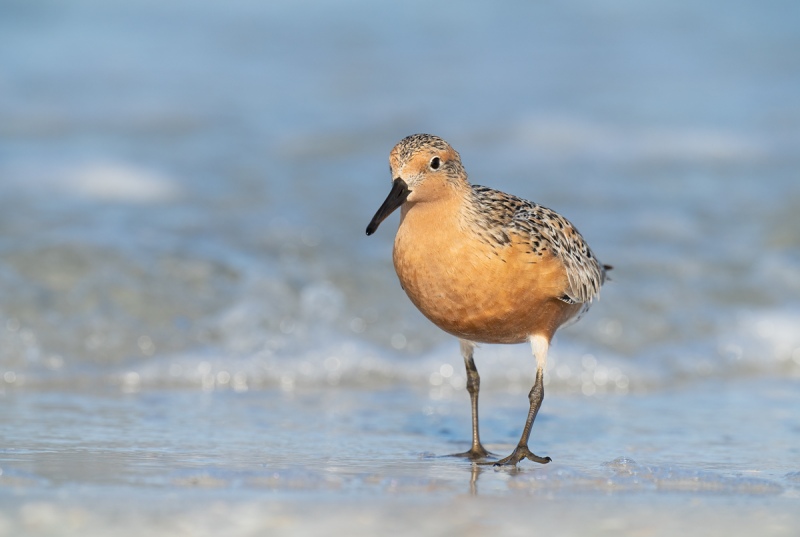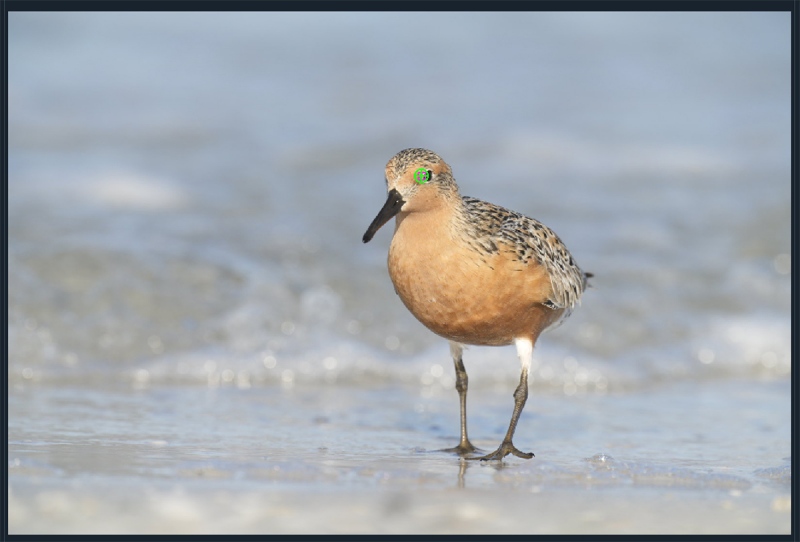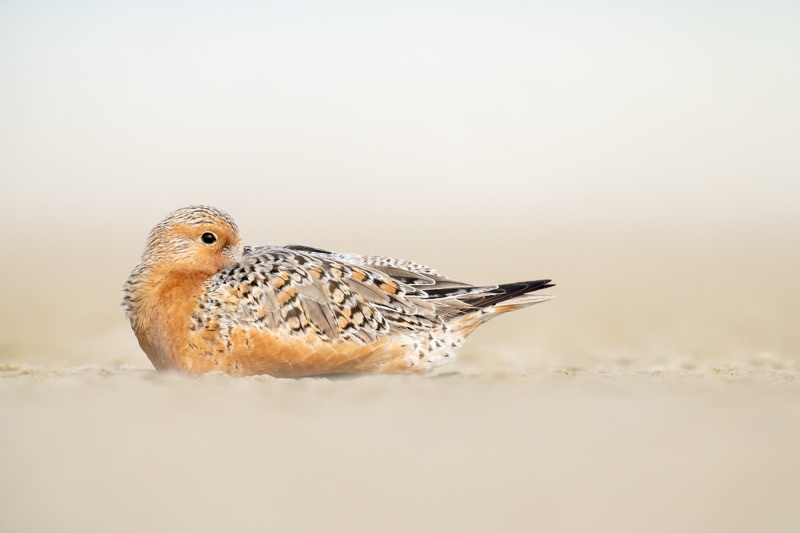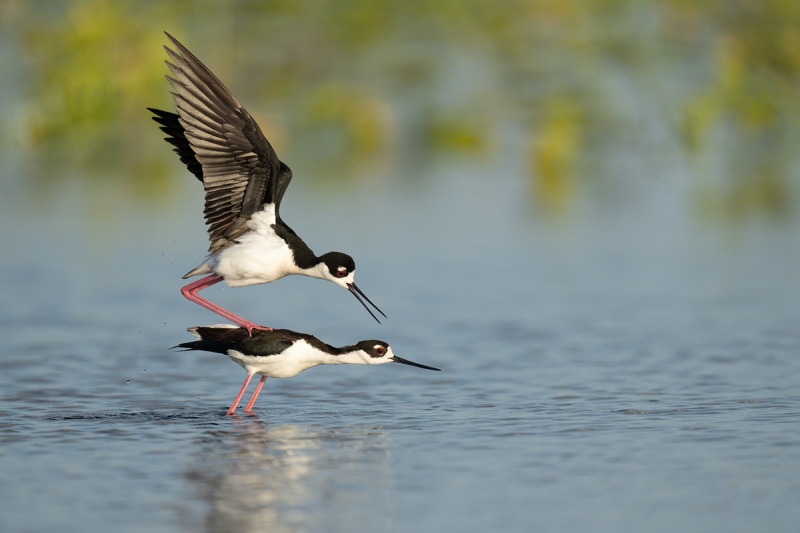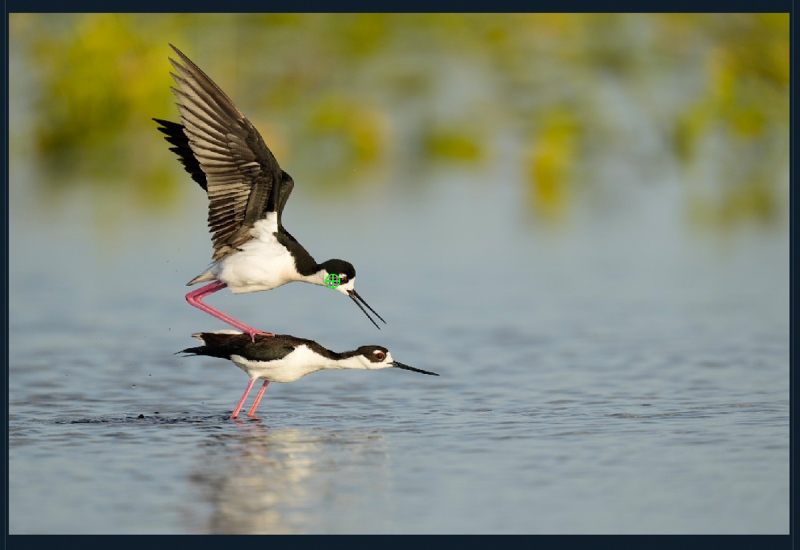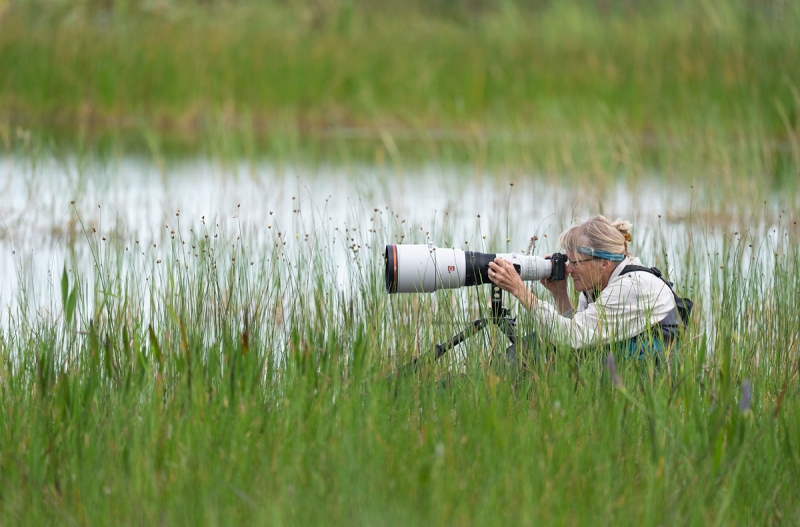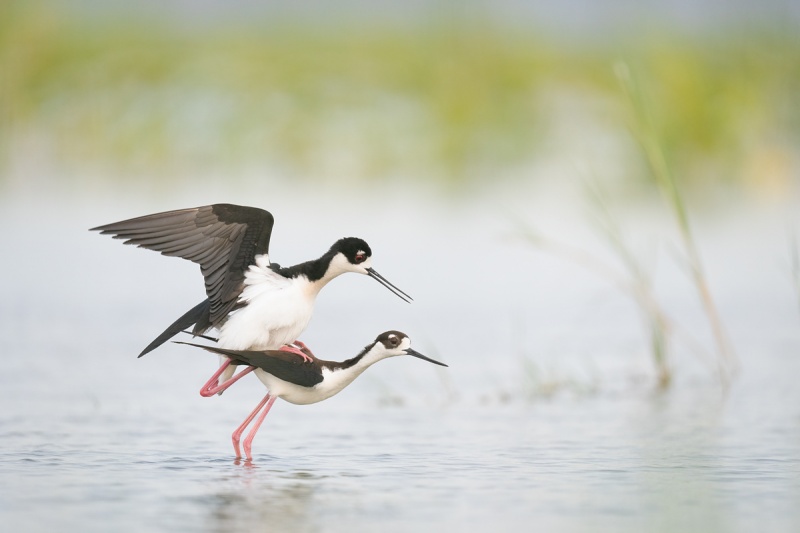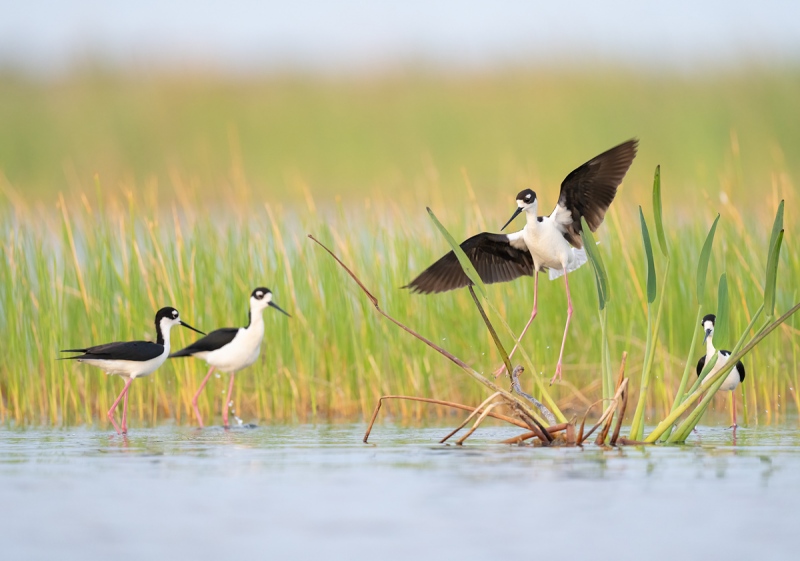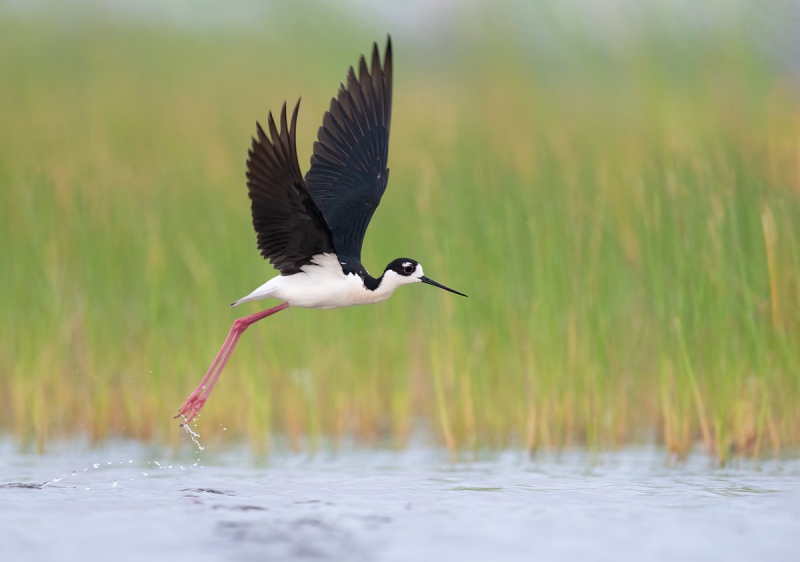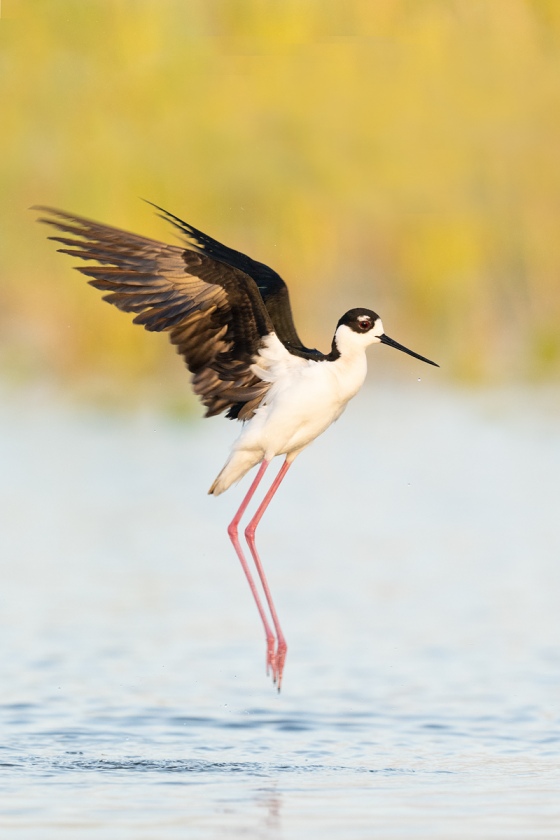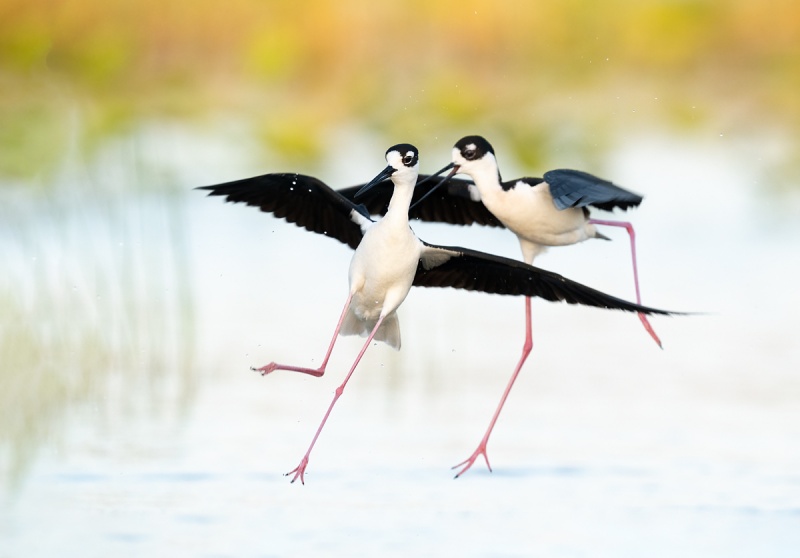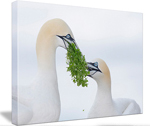May 18th, 2021 What’s Up?
Paradise Lost
On Monday morning, Anita North and I returned to our favorite Black-necked Stilt spot. For the most part, the birds did not cooperate. I took a walk with my tripod-mounted 600 GM/1.4X/ai and my milk crate and found a cooperative stilt in a nice setting and worked low with the legs of my tripod splayed so that I was working with the lens about nine inches above the surface of the water. I got some very nice stuff.
Paradise Found
We ended early and ran into ILE-neighbor John. He drives down most mornings to check on the crane families. He told me that he had heard of (but not seen) two recently-hatched chicks and directed us to the spot. We drove down, found the family, and realized that the pair that had lost two half-grown colts had double clutched, that is, re-nested successfully. Best of all, both the adults and the chicks are very tame. It is looking like a repeat of the 2020 Mother’s Day tale. I wish them luck while counting my blessings. Coincidentally, we had seen a Bobcat sun-bathing the morning before about a half mile from the new family … I will be calling this family Mother’s Day II.
Today
Today is Tuesday 18 May 2021. Clemens Van der Werf arrived last night and we had planned on an outing on his flats boat for this morning. But after seeing our images of the Black-necked Stilts and the tiny, brand new Mother’s Day II chicks, we will all be heading down to the marsh with our milk crates. The forecast for this morning if for partly cloudy with a breeze from the northeast. Wherever you are, and whatever you are doing, I hope that you have a great day.
This blog post took about an hour to prepare and makes 145 consecutive days with a new one. Please remember that if an item — a Delkin flash card, or a tripod head — for example, that is available from B&H and/or Bedfords and is also available in the BAA Online Store, it would be great if you opt to purchase from us. We will match any price. Please remember also to use my B&H affiliate links or to save 3% at Bedfords by using the BIRDSASART discount code at checkout. Doing either often earns you free guides and/or discounts. And doing so always earns my great appreciation.
Please Remember
With income from IPTs now at zero, please, if you enjoy and learn from the blog, remember to use one of my two affiliate programs when purchasing new gear. Doing so just might make it possible for me to avoid having to try to get a job as a Walmart greeter and will not cost you a single penny more. And if you use Bedfords and remember to enter the BIRDSASART code at checkout, you will save 3% on every order and enjoy free second-day air shipping. In these crazy times — I am out at least forty to sixty thousand dollars so far due to COVID 19 (with lots more to come) — remembering to use my B&H link or to shop at Bedfords will help me out a ton and be greatly appreciated. Overseas folks who cannot order from the US because of import fees, duties, and taxes, are invited to help out by clicking here to leave a blog thank you gift if they see fit.
New and Better Bedfords Discount Policy!
You can now save 3% on all of your Bedfords photo gear purchases by entering the BIRDSASART coupon code at checkout. Your discount will be applied to your pre-tax total. In addition, by using the code you will get 2nd day air shipping via Fed Ex.
Grab a Nikon AF-S Teleconverter TC-14E III and save $14.99. Purchase a Canon EOS R5 and your discount will be $116.97. Purchase a Sony FE 600mm f/4 GM OSS lens and save a remarkable $389.94! Your Bedford’s purchase no longer needs to be greater than $1,000.00 for you to receive a discount. The more you spend, the more you save.
Money Saving Reminder
Many have learned that if you need a hot photo item that is out of stock at B&H and would enjoy free second-day air shipping, your best bet is to click here, place an order with Bedfords, and enter the coupon code BIRDSASART at checkout. If an item is out of stock, contact Steve Elkins via e-mail or on his cell phone at (479) 381-2592 (Central time). Be sure to mention the BIRDSASART coupon code and use it for your online order to save 3% and enjoy free 2nd-day air shipping. Steve has been great at getting folks the hot items that are out of stock at B&H and everywhere else. The wait lists at the big stores can be a year or longer for the hard to get items. Steve will surely get you your gear long before that. For the past year, he has been helping BAA Blog folks get their hands on items like the SONY a9 ii, the SONY 200-600 G OSS lens, the Canon EOS R5, the Canon RF 100-500mm lens, and the Nikon 500mm PF. Steve is personable, helpful, and eager to please.


Gear Questions and Advice
Too many folks attending BAA IPTs (remember those?) and dozens of photographers whom I see in the field and on BPN, are–out of ignorance–using the wrong gear especially when it comes to tripods and more especially, tripod heads… Please know that I am always glad to answer your gear questions via e-mail
|
|
|
This image was created on 10 May 2021 on the first morning of my recent busman’s holiday at Fort DeSoto. Working while seated on the sand, I used the Induro GIT 304L/
Levered-Clamp FlexShooter Pro-mounted-Sony FE 600mm f/4 GM OSS lens, the Sony FE 2.0x Teleconverter, and The One, the Sony Alpha 1 Mirrorless Digital Camera (Body Only). ISO 800. The exposure was determined by Zebras with ISO on the rear wheel: 1/1000 sec. at f/9 (stopped down 1/3 stop) in Manual mode. AWB at 8:26am on a sunny morning.
Tracking: Expand Spot/AF-C was active at the moment of exposure and performed perfectly. Click on the image to enjoy a larger version.
Image #1: Red Knot almost fully molted into breeding plumage — in the Gulf surf
|
In Search of the Perfect Field Guide Portrait
I headed back to DeSoto in hopes of finding a Red Knot in 100% breeding plumage and creating the perfect field guide portrait, an image from the side showing the spectacularly patterned feathers of the back and the coverts of a fully molted bird. This bird was pretty close, but never turned to give me the profile shot I wanted …
|
|
Image #1A: AF Point screen capture for the Red Knot almost fully molted into breeding plumage — in the Gulf surf image
|
You-Gotta-Be-Kidding-Me AF Performance
Can your camera body detect and track the eye of an active shorebird as it forages along the edge of the surf? At 1200mm? The Sony Alpha a1 can. You will not get consistent results unless your camera is set up exactly right. If you own an a1 and are not getting the AF performance that you want and expect, consider joining the SONY a1 Info and Updates group. Scroll down for details.
|
|
|
This image was created on 12 May 2021 on the third morning of my recent busman’s holiday at Fort DeSoto. Working on the Panning Ground Pod, I used the Sony FE 600mm f/4 GM OSS lens, the Sony FE 2.0x Teleconverter, and The One, the Sony Alpha 1 Mirrorless Digital Camera (Body Only). ISO 1000. The exposure was determined by Zebras with ISO on the rear wheel: 1/800 sec. at f/8 (wide open) in Manual mode. AWB at 9:09am in cloudy bright conditions.
Tracking: Expand Spot/AF-C was active at the moment of exposure and performed perfectly. Click on the image to enjoy a larger version.
Image #2: Red Knot partially molted into breeding plumage resting on sand flat
|
Hard Work …
Wednesday morning started off great and I made some Marbled Godwit and Dunlin in heaven images working in the soft light on the Panning Ground Pod. Next was a fishing Snowy Egret in the surf and a close-to-shore diving frigatebird. Then I crawled and rolled my way about 40 yards on a sand flat with the 600 GM/2X TC/a1 along for the ride in an effort to isolate a Red Knot. The only one that I was able to single out was the sleeping bird in Image #2. I was so knackered that morning that I went for a swim in the Gulf.
Anita is headed back to Canada this coming Friday. I just might head over to DeSoto for another busman’s holiday …
Sony Alpha a1 AF
Barring operator error, the performance of the Sony Alpha a1 AF system at any focal length — including 1200mm as in Image #1 above, is, when the a1 is set up properly as detailed in the in e-mails to the Sony Alpha a1 Info & Updates group, more than remarkable. Early on, there was lots of discussion within the group with many preferring multiple back button approaches. For me a simple shutter button approach with the right AF settings that yield 99% sharp-on-the-eye images is best. By far. It is super-simple and mega-effective. In the next SONY Alpha a1 Set-up and Info Group e-mail, I will be sharing what I have learned as to when and it what situations it is best to abandon Wide. And with what. The group has already learned to limit the AF Area choices and to switch AF Areas quickly and conveniently. The default method of switching AF points with the C2 button is both slow and cumbersome.
SONY Alpha a1 Set-up and Info Group
The SONY Alpha a1 Set-up and Info Group is going great guns as folks chime in with thoughtful questions and experience-based advice. We are now up to an astounding 46 lucky folks. Early on, we discussed the myriad AF options. I gave my opinion as to the best one for flight and general bird photography. More recently, we have been in contact with folks at SONY sharing our thoughts, experiences, and frustrations with the EVF blackout problem.
All who purchased their Alpha a1 bodies via a BAA affiliate link will receive a free subscription to the Sony Alpha a1 Set-Up and Info Updates after shooting me their receipts via e-mail. (Note: it may take me several days to confirm B&H orders.) This same service may be purchased by anyone with an a1 body via a $150.00 PayPal sent to birdsasart@verizon.net indicating payment for Alpha a1 Info Updates. Alternatively, folks can call Jim weekdays at 1-863-692-0906 to pay via credit card. New members will receive composite e-mails that summarize all previous discussions.
Typos
With all blog posts, feel free to e-mail or to leave a comment regarding any typos or errors.
May 17th, 2021 What’s Up?
On Sunday morning we sat in the marsh again and enjoyed another great day with the Black-necked Stilts. Again, they landed right in front of us and copulated. Twice. In addition, we got some great stuff on Boat-tailed Grackles grabbing snails. Toward the end of the session, I did some ultra-low-level shooting off the tripod with the Levered-clamp FlexShooter Pro. That gets me down to about a foot above the mud. I am getting better and better at working off the rear monitor. Techniques for doing that will be shared here soon.
Thanks to all who left comments on Anita’s images yesterday. As I wrote in reply to one comment, Anita’s images are not perfect. Had anyone pointed out some of the legitimate flaws, I would have thanked them very much. The point of the post, however, was that she worked very hard to discover a new location and got some very good images. Not to mention that the first three images were made in extreme low light conditions. I have been preaching here for years that depth of field with super-telephoto lenses, especially with subjects at relatively close range, is very shallow. And some folks on BPN often ask for “more d-o-f” in low light-, already high ISO-, slow shutter speed situations. That is why for decades, my mantra has been to focus on the eye, get that sharp, and to heck with depth of field.
There are many other comments and replies worth reading. Learn more about d-o-f with long lenses in today’s post below.
Today is Monday 17 May 2021. The forecast is for still and sunny with a light breeze from the northeast developing. We are heading down to the lake early. Wherever you are, and whatever you are doing, I hope that you have a great day.
This blog post took about two hours to prepare and makes 144 consecutive days with a new one. Please remember that if an item — a Delkin flash card, or a tripod head — for example, that is available from B&H and/or Bedfords and is also available in the BAA Online Store, it would be great if you opt to purchase from us. We will match any price. Please remember also to use my B&H affiliate links or to save 3% at Bedfords by using the BIRDSASART discount code at checkout. Doing either often earns you free guides and/or discounts. And doing so always earns my great appreciation.
Please Remember
With income from IPTs now at zero, please, if you enjoy and learn from the blog, remember to use one of my two affiliate programs when purchasing new gear. Doing so just might make it possible for me to avoid having to try to get a job as a Walmart greeter and will not cost you a single penny more. And if you use Bedfords and remember to enter the BIRDSASART code at checkout, you will save 3% on every order and enjoy free second-day air shipping. In these crazy times — I am out at least forty to sixty thousand dollars so far due to COVID 19 (with lots more to come) — remembering to use my B&H link or to shop at Bedfords will help me out a ton and be greatly appreciated. Overseas folks who cannot order from the US because of import fees, duties, and taxes, are invited to help out by clicking here to leave a blog thank you gift if they see fit.
New and Better Bedfords Discount Policy!
You can now save 3% on all of your Bedfords photo gear purchases by entering the BIRDSASART coupon code at checkout. Your discount will be applied to your pre-tax total. In addition, by using the code you will get 2nd day air shipping via Fed Ex.
Grab a Nikon AF-S Teleconverter TC-14E III and save $14.99. Purchase a Canon EOS R5 and your discount will be $116.97. Purchase a Sony FE 600mm f/4 GM OSS lens and save a remarkable $389.94! Your Bedford’s purchase no longer needs to be greater than $1,000.00 for you to receive a discount. The more you spend, the more you save.
Money Saving Reminder
Many have learned that if you need a hot photo item that is out of stock at B&H and would enjoy free second-day air shipping, your best bet is to click here, place an order with Bedfords, and enter the coupon code BIRDSASART at checkout. If an item is out of stock, contact Steve Elkins via e-mail or on his cell phone at (479) 381-2592 (Central time). Be sure to mention the BIRDSASART coupon code and use it for your online order to save 3% and enjoy free 2nd-day air shipping. Steve has been great at getting folks the hot items that are out of stock at B&H and everywhere else. The wait lists at the big stores can be a year or longer for the hard to get items. Steve will surely get you your gear long before that. For the past year, he has been helping BAA Blog folks get their hands on items like the SONY a9 ii, the SONY 200-600 G OSS lens, the Canon EOS R5, the Canon RF 100-500mm lens, and the Nikon 500mm PF. Steve is personable, helpful, and eager to please.


Gear Questions and Advice
Too many folks attending BAA IPTs (remember those?) and dozens of photographers whom I see in the field and on BPN, are–out of ignorance–using the wrong gear especially when it comes to tripods and more especially, tripod heads… Please know that I am always glad to answer your gear questions via e-mail
|
|
|
This image was created on 15 May 2021, my first morning of sitting on a milk crate in the marsh along the lakeshore at ILE. I used the Induro GIT 304L/Levered-clamp FlexShooter Pro-mounted-Sony FE 600mm f/4 GM OSS lens and The One, the Sony Alpha 1 Mirrorless digital camera. ISO 500. Exposure determined via Zebras with ISO on the rear dial: 1/4000 sec. at f/4 (wide open) in Manual mode. AWB at 7:39am on a clear sunny morning.
Wide/AF-C was active at the moment of exposure and performed perfectly by nailing the plover’s eye. Click on the image to see a larger version.
Image #1: Black-necked Stilts, pre-copulatory stand
|
Thanks! Anita
Thanks to Anita for coming up with the idea of sitting on a milk crate in the marsh. It is something that I will be doing quite often — not only in May, but throughout the year. Right now, however, the opportunities have been amazing. We can hardly wait to get up each day and head down to the lake. I’ve gone down the last two mornings, and we’ve had two copulations right in front of us each day. Plus numerous fights between pairs from abutting territories.
The courtship rituals of all members of the Recurvirostridae family, the stilts and avocets, are entirely fascinating and beautiful. You will be seeing images here over the next few weeks of the various courtship behaviors. I have seen this species in previous years as the water level in the lake drops, but had only photographed them from afar (and not very well) working at 1200mm. As long as we sit and stay still, they come right up to us. Today is day four for Anita, and day three for me. We have been improving our strategies and techniques each day and will continue to do so.
And who knows, perhaps they will nest successfully this year at ILE for the first time … I have never seen a BNST chick here …
Depth of Field with Super-telephoto Lenses
I have attempted to share the information below here on the blog for many years. But after reading some of the comments on yesterday’s blog post, my teachings — for some folks — have fallen on deaf ears. Here are the facts:
Depth-of-field (d-o-f) with super-telephoto lenses is extremely shallow when working at or near the wide open aperture. The closer you are to the subject, the less the d-o-f. Working a 600mm lens at 15 feet at f/4, the total d-o-f is less than 1/4 inch. Increase the distance to 50 feet, and the d-o-f increases to roughly 3 3/4 inches. In each situation, stopping down two full stops roughly doubles to the total d-o-f. Note that with super-telephoto lenses, the d-o-f is about 50/50 with half of the d-o-f in front of the point of focus, and half behind.
Today’s featured image was created at a distance of about 50 feet, perhaps 60. Though the d-o-f was 5.4 inches at most, that was more than enough to cover both subjects. How do we know that? Because both birds are razor sharp.
I recommend stopping down with long lenses when you are very close to the subject. But realize then that the additional d-o-f you will gain will be minimal. Again, the d-o-f roughly doubles for each two stops that you stop down. But folks need to understand that there is a price to pay when stopping down. Stopping down two stops will cost you either two stops of shutter speed or two stops of ISO (or some combination of the two).
My strategy for three and and half decades has been to focus on the bird’s eye and let the d-o-f fall where it may. Unless you can verbalize a good reason for stopping down.
|
|
Image #1A: AF Points for the Black-necked Stilts, pre-copulatory stand image
|
You-Gotta-Be-Kidding-Me AF Performance
Can your camera body detect and track the eye of a Black-necked Stilt, a dark red eye buried in a black cap? The Sony Alpha a1 can. Easily. As for the Sony Alpha a1 AF system, what can I say? The results that you see above are typical of those achieved with Animal Eye Tracking. You will not, however, get consistent results easily unless your AF Menu is set up correctly. If you own an a1, and are not getting the AF performance that you want and expect, consider joining the SONY a1 Info and Updates group. If you are planning on purchasing an a1 — the world’s best camera for bird photography, be sure to use one of my two affiliate links and earn free entry into the group. Details immediately below.
Sony Alpha a1 AF
Barring operator error, the performance of the Sony Alpha a1 AF system at any focal length — as we saw recently even at 1200mm — when your a1 is set up properly as detailed in the in e-mails to the Sony Alpha a1 Info & Updates group, more than remarkable. Early on, there was lots of discussion within the group with many preferring multiple back button approaches. For me a simple shutter button approach with the right AF settings that yield 99% sharp-on-the-eye images is best. By far. It is super-simple and mega-effective. In the next SONY Alpha a1 Set-up and Info Group e-mail, I will be sharing what I have learned as to when and it what situations it is best to abandon Wide. We have already learned to limit the AF Area choices and to switch AF Areas quickly and conveniently. The default method of switching AF points with the C2 button is both slow and cumbersome.
SONY Alpha a1 Set-up and Info Group
The SONY Alpha a1 Set-up and Info Group is going great guns as folks chime in with thoughtful questions and experience-based advice. We are now up to an astounding 41 folks. Early on, we discussed the myriad AF options. I gave my opinion as to the best one for flight and general bird photography. More recently, we have been in contact with folks at SONY sharing our thoughts, experiences, and frustrations with the EVF blackout problem.
All who purchased their Alpha a1 bodies via a BAA affiliate link will receive a free subscription to the Sony Alpha a1 Set-Up and Info Updates after shooting me their receipts via e-mail. (Note: it may take me several days to confirm B&H orders.) This same service may be purchased by anyone with an a1 body via a $150.00 PayPal sent to birdsasart@verizon.net indicating payment for Alpha a1 Info Updates. Alternatively, folks can call Jim weekdays at 1-863-692-0906 to pay via credit card. New members will receive composite e-mails that summarize all previous discussions.
Typos
With all blog posts, feel free to e-mail or to leave a comment regarding any typos or errors.
May 16th, 2021 Which?
Which of Anita North’s five images do you think is the strongest? Why? Also, you may wish to learn something by trying to answer the Aperture Errors Question below.
What’s Up?
Early on Saturday morning, I sat on a plastic milk crate in the marsh behind my tripod-mounted 600 GM/a1. Anita was to my left with the same gear, sitting on a small plastic stool. Two minutes after we were in place two Black-necked Stilts flew in and landed right in front of us. That was just the beginning of a truly great morning.
I did lots of catching up on e-mails and doing critiques in the Avian Forum at BPN. Since 12-13-2007, I have commented on or created 31,339 threads. I was pleased to learn that Dan Womack sold his Canon EF 100-400 f/4.5-5.6L IS II lens in mint condition for $1449.00 within hours of it being listed in yesterday’s blog post.
Today is Sunday 16 May 2021 and the forecast is perfect for sitting in the marsh: mostly sunny with a soft northeast breeze!. So that is exactly what we will be doing at 6:45am. Wherever you are, and whatever you are doing, I hope that you have a great day.
This blog post took about two hours to prepare and makes 143 consecutive days with a new one. Please remember that if an item — a Delkin flash card, or a tripod head — for example, that is available from B&H and/or Bedfords and is also available in the BAA Online Store, it would be great if you opt to purchase from us. We will match any price. Please remember also to use my B&H affiliate links or to save 3% at Bedfords by using the BIRDSASART discount code at checkout. Doing either often earns you free guides and/or discounts. And doing so always earns my great appreciation.
Please Remember
With income from IPTs now at zero, please, if you enjoy and learn from the blog, remember to use one of my two affiliate programs when purchasing new gear. Doing so just might make it possible for me to avoid having to try to get a job as a Walmart greeter and will not cost you a single penny more. And if you use Bedfords and remember to enter the BIRDSASART code at checkout, you will save 3% on every order and enjoy free second-day air shipping. In these crazy times — I am out at least forty to sixty thousand dollars so far due to COVID 19 (with lots more to come) — remembering to use my B&H link or to shop at Bedfords will help me out a ton and be greatly appreciated. Overseas folks who cannot order from the US because of import fees, duties, and taxes, are invited to help out by clicking here to leave a blog thank you gift if they see fit.
New and Better Bedfords Discount Policy!
You can now save 3% on all of your Bedfords photo gear purchases by entering the BIRDSASART coupon code at checkout. Your discount will be applied to your pre-tax total. In addition, by using the code you will get 2nd day air shipping via Fed Ex.
Grab a Nikon AF-S Teleconverter TC-14E III and save $14.99. Purchase a Canon EOS R5 and your discount will be $116.97. Purchase a Sony FE 600mm f/4 GM OSS lens and save a remarkable $389.94! Your Bedford’s purchase no longer needs to be greater than $1,000.00 for you to receive a discount. The more you spend, the more you save.
Money Saving Reminder
Many have learned that if you need a hot photo item that is out of stock at B&H and would enjoy free second-day air shipping, your best bet is to click here, place an order with Bedfords, and enter the coupon code BIRDSASART at checkout. If an item is out of stock, contact Steve Elkins via e-mail or on his cell phone at (479) 381-2592 (Central time). Be sure to mention the BIRDSASART coupon code and use it for your online order to save 3% and enjoy free 2nd-day air shipping. Steve has been great at getting folks the hot items that are out of stock at B&H and everywhere else. The wait lists at the big stores can be a year or longer for the hard to get items. Steve will surely get you your gear long before that. For the past year, he has been helping BAA Blog folks get their hands on items like the SONY a9 ii, the SONY 200-600 G OSS lens, the Canon EOS R5, the Canon RF 100-500mm lens, and the Nikon 500mm PF. Steve is personable, helpful, and eager to please.


Gear Questions and Advice
Too many folks attending BAA IPTs (remember those?) and dozens of photographers whom I see in the field and on BPN, are–out of ignorance–using the wrong gear especially when it comes to tripods and more especially, tripod heads… Please know that I am always glad to answer your gear questions via e-mail
|
|
|
This image was created on 14 May 2021 down by the lake at ILE. Working from my SUV with the lens resting on a lowered window, I used Sony FE 600mm f/4 GM OSS lens and The One, the Sony Alpha 1 Mirrorless digital camera. ISO 800. Exposure determined via Zebras with ISO on the rear dial: 1/500 sec. at f/4 (wide open) in Manual mode. AWB at 7:30am on a cloudy morning.
Zone/AF-C was active at the moment of exposure and performed perfectly. Click on the image to see a larger version.
Image #1: Anita North in marsh
|
I Thought She Was Nuts!
When I first saw Anita sitting in the marsh, I thought that she was nuts. She had been observing the stilts on and off for about a week and had faith that they would land in front of her. That despite that fact that I had recently sat at the edge of a small mudflat at DeSoto and had firmly believed that if you sat, they would come.
|
|
|
This image was created on 14 May 2021 by Anita North in the marsh along the lakeshore at ILE. She used the
Induro GIT 304L/Mongoose M3.6-mounted Sony FE 600mm f/4 GM OSS lens and The One, the Sony Alpha 1 Mirrorless digital camera. ISO 5000. Exposure determined via Zebras with ISO on the rear dial: 1/500 sec. at f/4.5 (stopped down 1/3 stop in error) in Manual mode. AWB at 7:00am on a cloudy morning.
Zone/AF-C was active at the moment of exposure and performed perfectly by nailing the plover’s eye. Click on the image to see a larger version.
Image #2: Black-necked Stilts copulating
Image courtesy of an copyright 2021: Anita North
|
Copulations
The first pair that landed in front of Anita did the whole courtship deal: the female crouched in invitation while the male strutted around her splashing water with his bill. Then he mounted, her and they copulated. When he hopped off her, he put one raised wing over his mate, and they intertwined their necks in a seemingly loving embrace. Not a bad way to start!
|
|
|
This image was also created on 14 May 2021 by Anita North in the marsh along the lakeshore at ILE. She used the Induro GIT 304L/Mongoose M3.6-mounted Sony FE 600mm f/4 GM OSS lens and The One, the Sony Alpha 1 Mirrorless digital camera. ISO 3200. Exposure determined via Zebras with ISO on the rear dial: 1/500 sec. at f/4 (wide open) in Manual mode. AWB at 7:03am on a cloudy morning.
Zone/AF-C was active at the moment of exposure and performed perfectly by nailing the plover’s eye. Click on the image to see a larger version.
Image #3: Black-necked Stilts starting to squabble
Image courtesy of an copyright 2021: Anita North
|
The Squabbles
As many as six stilts are often involved in fairly violent, exceedingly-difficult-to-photograph squabbles. In a way, Anita was lucky on her first attempt to have a cloudy morning. As there was no sun, she was able to photograph birds in positions where they would have been terribly sidelit on a clear morning.
|
|
|
This image was also created on 14 May 2021 by Anita North in the marsh along the lakeshore at ILE. She used the Induro GIT 304L/Mongoose M3.6-mounted Sony FE 600mm f/4 GM OSS lens and The One, the Sony Alpha 1 Mirrorless digital camera. ISO 2500. Exposure determined via Zebras with ISO on the rear dial: 1/1000 sec. at f/4 (wide open) in Manual mode. AWB at 7:07am on a cloudy morning.
Zone/AF-C was active at the moment of exposure and performed perfectly. Click on the image to see a larger version.
Image #4: Black-necked Stilt in flight
Image courtesy of an copyright 2021: Anita North
|
Flight Opportunities
On occasion, there are decent flight chances with the BNSTs as they fly to and from their three favorite spots well to the left of the pier. In addition, there is no telling what will fly by: Great and Snowy Egrets, Green, Little Blue, and Tricolored Herons, Fish Crow, Red-winged Blackbird, Boat-tailed Grackle, Black-bellied Whistling Duck, Mottled Duck, Osprey, and Bald Eagle are all likely.
|
|
|
This image was created on 15 May 2021 by Anita North in the marsh along the lakeshore at ILE. She used the Induro GIT 304L/Mongoose M3.6-mounted Sony FE 600mm f/4 GM OSS lens and The One, the Sony Alpha 1 Mirrorless digital camera. ISO 2500. Exposure determined via Zebras with ISO on the rear dial: 1/1000 sec. at f/5.6 (stopped down 1 stop in error) in Manual mode. AWB at 6:54am on just before sunrise.
Tracking: Zone/AF-C was active at the moment of exposure and performed perfectly by nailing the plover’s eye. Click on the image to see a larger version.
Image #5: Black-necked Stilt flapping after bath
Image courtesy of an copyright 2021: Anita North
|
Aprés Bath
On a recent IPT, I called out that a Willet would jump into the air and flap. I even predicted that the bird would turn to its right before jumping up. That, after repeatedly dipping its breast in the water and splashing around. Several folks were stunned. How did you know that that would happen? More than nine times out of ten, when you see a bird, any bird, dipping its breast in the water to bathe, it will flap in place and then jump up and flap some more as it heads back to the shoreline. And since the wind was from behind us, I knew that it would turn so that it could flap (and fly) into the wind. Knowledge of bird behavior can get you images that you might otherwise miss.
|
|
|
This image was also created on 15 May 2021 by Anita North in the marsh along the lakeshore at ILE. She used the Induro GIT 304L/Mongoose M3.6-mounted Sony FE 600mm f/4 GM OSS lens and The One, the Sony Alpha 1 Mirrorless digital camera. ISO 2500. Exposure determined via Zebras with ISO on the rear dial: 1/1000 sec. at f/5.6 (stopped down 1 stop in error) in Manual mode. AWB at 6:53am just before sunrise.
Tracking: Zone/AF-C was active at the moment of exposure and performed perfectly by nailing the plover’s eye. Click on the image to see a larger version.
Image #6: Black-necked Stilts battling
Image courtesy of an copyright 2021: Anita North
|
The Holy Grail Shot!
It seem that the stilts from adjoining territories will meet up to fight just once each morning. On day two in the marsh, the big battle took place right in front of us. I pretty much fanned on all of my attempts as I struggled to properly frame the combatants as they jumped into the air. Anita did a great job with this one.
Aperture Errors Question
Anita made three errors in setting the aperture. Take a close look at the EXIF for images #2, #5, & #6 and see if you can figure out what she did wrong. If you think that you know, please leave your explanation in a comment. On a higher level, let us know if you can figure out why she made the error with images #5 & #6.
The Great News!
Anita is headed back to Toronto in about a week. The best news for me is that her strategy for photographing in the marsh while sitting on a milk crate (or in the water, to get even lower), will continue to pay dividends for me personally for years to come (at various settings).
Typos
With all blog posts, feel free to e-mail or to leave a comment regarding any typos or errors.
|
|




